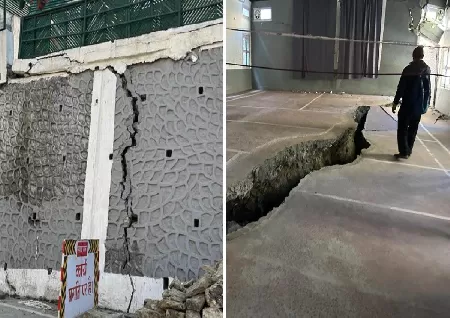Joshimath Can No Longer Sustain Increasing Pressure, Warns Senior Geologist as Himalayan Town Sinks

Senior geologist issues warning that Joshimath, a town in the Himalayas,
Can no longer sustain the mounting strain.The Joshimath region of Uttarakhand is currently experiencing the collapse of hundreds of homes. Huge amounts of water are spilling out of the perilous cracks in the walls of houses and roads, which are enlarging. But according to scientists, the catastrophe that struck the Himalayan village was years in the making and is only going to grow worse.
"The region's land has been sinking for a very long time and is still sinking. Over the remains of a previous landslide, the settlement was constructed. It is particularly susceptible to landslides and is in Seismic Zone 5, which has the highest risk of earthquakes "
and has the same landslide vulnerability, "Dr. Kalachand Sain, a renowned geologist and the director of the Wadia Institute of Himalayan Geology in Dehradun, explains.
The 2021 assessment, which was led by a renowned institute, highlighted the area's significant vulnerability and questioned geological foundation. The region is not only the most seismically active because of the ongoing subduction of the Indian Plate beneath the Eurasian Plate, but it is also becoming more unstable as the pressure from human activity increases.
ANONYMOUS CONSTRUCTION
The village is located in the Chamoli district at an elevation of almost 6,000 feet, and the geologist noted that there has been significant subsurface activity in the area.
Over time, a significant amount of strain energy has built up, which is released as earthquakes and frequently causes landslides. The rising surface pressure brought on by human activity is on top of it.
Despite the government-established Mishra committee issuing a stern warning in 1976, a number of hotels, restaurants, structures, and roads have been constructed in the region to accommodate tourism. The natural flow of water has been further impeded by the poorly designed drainage system, forcing it to leak out from unexpected locations.
"We must allow the water to flow naturally." The entire drainage system needs to be redesigned, and impervious building materials that prevent water from seeping down must be used so that it does not exert undue pressure on the system's components.
he emphasised, "and pour out of fractures, making the earth unstable.
The 510 MW Tapovan Vishnugad Hydropower Project of the National Thermal Power Corporation (NTPC) is being built in the district despite the severe floods of previous year. "It is impossible to say with certainty whether the fissures were brought on by the development of a certain project." However, we cannot rule it out. Sain continued, "Rocks blasted in steep places might cause damage and start subsidence.
Foundation instability and enlarging river channels
Geologists have also observed that rivers and "nullahs" are becoming less free to flow naturally upstream over time. The groundwater is finding a new route to flow since the underground aquifers can no longer tolerate the escalating surface pressure.
Additionally, rivers are enlarging their channels, which loosens sediments as they flow downstream and makes rocks more vulnerable to erosion (a process known as toe-cutting).
As a result of the numerous streams that pour down Joshimath's slope, there is significant erosion. The foundation of the place is weakened because of how easily the weathered rocks slip downstream. Therefore, structures would similarly be unstable if pressure on the surface persisted and they were erected. This is a significant factor in why these homes are forming significant fractures, he said.
WORSE TO COME
The Himalayan region is likely to see more calamities of this kind as the effects of climate change worsen. The area would become more vulnerable to land subsidence as a result of flash floods and landslides brought on by the anticipated rise in severe rainfall occurrences. This just indicates that the sinking Joshimath would face some difficult times.
"We need to keep a closer eye on this area." Increase the number of sensors and delicate equipment in use to monitor all subsurface changes. But first, we should consider limiting any development in the zones with the highest vulnerability. Allow the waters to flow as they naturally would. Plan new drainage strategies. The majority of these homes, which have developed cracks, are now uninhabitable.But if we're going to allow people to live here, we need to develop a solid, resilient plan," Sain said.
Related queries to this article
- The Joshimath region
- Uttarakhand
- the collapse of hundreds of homes
Read more articles and stories on InstaSity Trending Topics.